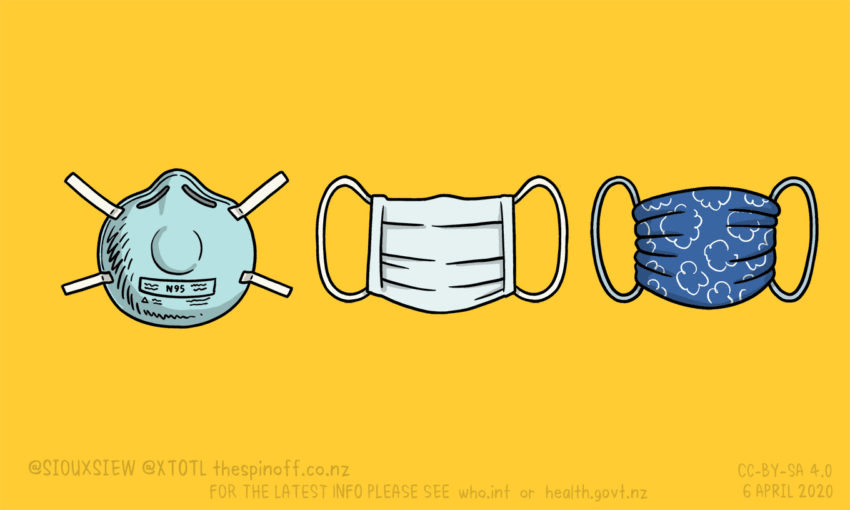The simple rules for wearing face masks during levels two and three – and how they can effectively limit the spread of Covid-19
Lots of people might be wondering why we’re now being asked to wear face masks when we didn’t use them the first time we were stamping out Covid-19 in Aotearoa New Zealand. Back in April I wrote about how even the experts couldn’t agree whether masks should be worn by everyone. Some of that disagreement was based on different studies saying different things, and the worry that if everyone rushed out to buy face masks there wouldn’t be enough for those who really needed them.
Now it’s August, and things have moved on a lot in four months. We certainly understand much more about how the virus is transmitted from person to person. Early on it was thought that coughs and sneezes were one of the main routes of transmission. Instead, it turns out that people are also infectious for a few days before they develop symptoms, and in that time they can spread the virus through breathing, talking, shouting and singing. That’s where masks fit in. But first, a quick reminder about the different types of masks.
N95s, surgical masks, and cloth masks
N95 respirators are designed to protect the wearer from breathing in or swallowing droplets and very small particles – like bacteria and viruses. To work, N95s need to form a tight seal around your face. That means first having a “fit test” to ensure the mask forms a proper seal. If you’ve a beard, forget it. Because N95s are designed to form a tight seal they can become very uncomfortable as heat and humidity build up. As with all masks, people need training to put them on and off without contaminating themselves or the mask. Importantly, N95s are needed by healthcare workers who are caring for people with Covid-19.
Surgical masks are disposable, loose-fitting face masks that cover your nose, mouth and chin. They’re mainly used to protect the wearer from sprays and splashes, or to stop the wearer from spreading their respiratory secretions to others – like a patient during surgery. Cloth masks are homemade versions of surgical masks made out of whatever you have to hand.
Using masks to help limit the spread of Covid-19
We’re asking people to wear surgical or cloth masks as they can help to limit the spread of the virus by people who are infectious and don’t yet know it. Just the simple act of talking to someone can have a high risk of transmitting the virus if neither person is wearing a mask. This risk is reduced if the infectious person is wearing a mask and reduced even further if both people are wearing a mask.
A recent study used a simple laser beam and mobile phone camera setup to test how many droplets were recorded when someone spoke while wearing different kinds of masks. The results show that most masks are pretty effective at reducing droplets compared to wearing no mask, with the exception of masks made of fleece. That means making a simple mask out of an old t-shirt or hanky will do just fine.
Check out this video by Dr Michelle Dickinson from Nanogirl Labs showing how to make a simple mask that doesn’t involve any sewing.
Four simple rules for wearing a mask
The important thing about wearing any kind of mask is to follow these four simple rules:
- Make sure you wash your hands before and after putting the mask on and off. This will help prevent contamination of your hands and the outside of the mask if you are infectious.
- Don’t fiddle with it. If you do, please wash your hands.
- Make sure the mask covers your mouth and your nose. If it’s only covering your mouth, it won’t be as effective.
- Don’t use a mask with a valve on it. These are designed to stop the build-up of humid air and are for when masks are worn to protect the wearer. That means that unless the valve also has a filter that specifically filters out particles as small as viruses, if you are infectious, you’ll be releasing the virus instead of containing it.
If using a cloth mask, best to have a few for each family member. After each use pop them on a hot wash (60°C) and make sure they are dry before wearing again.
Related:
Everything you need to know about buying and making face masks
Masks are about looking out for each other
In summary, wearing a mask is about protecting your community in case you are infectious and don’t know it. When we’re at alert level two or three, this is one way we can help stop the spread of Covid-19.

